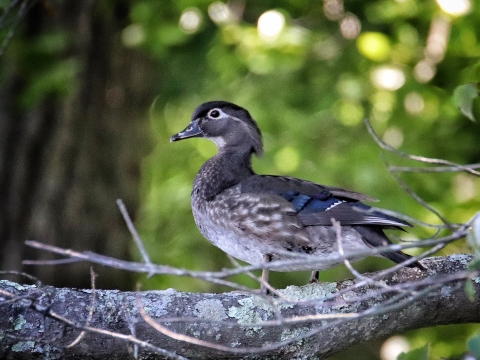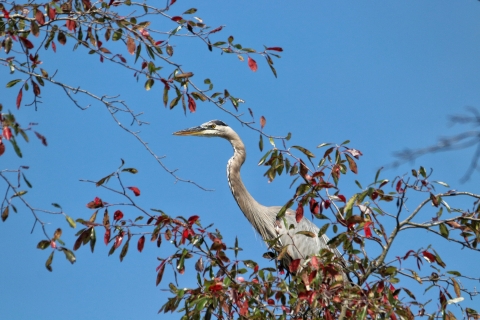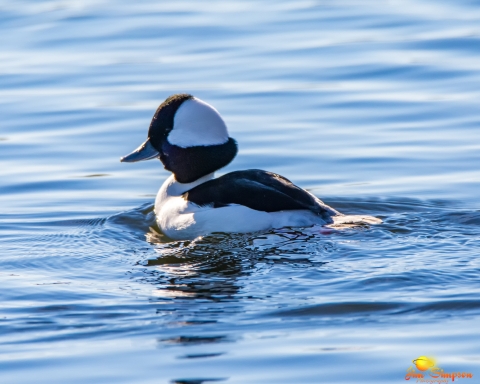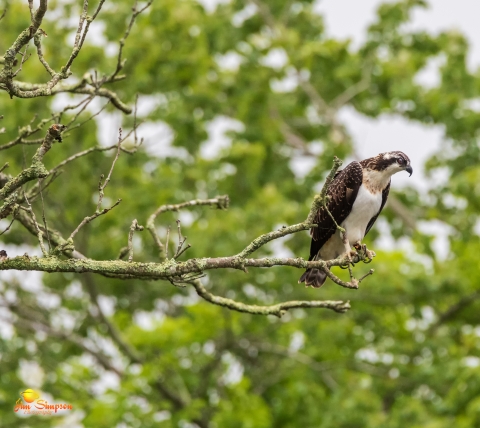Seasons of Wildlife
A River for All Seasons
Spring breeds new life
Spring is full of activity along the Carmans River. By late March, osprey return to refurbish their large, stick nests. The spikes of the skunk cabbage emerge along the riverbanks and the flowers of the swamp maple bloom red and yellow. The call of breeding spring peepers from nearby ponds can be heard in the late afternoon hours. On sunny days, turtles warm themselves on the river’s edge. Among the Phragmites, male redwing blackbirds establish their breeding territories and show off their red shoulder patches. Green herons return from the south, while out near the Bay, the bufflehead congregate before moving to breeding grounds farther north.
Summertime nurseries burst with color
By late spring and early summer many birds are raising their families. Be careful not to approach the nest or young of the mute swan; they can be very aggressive when threatened. Beautiful wood ducks nest in June; you will see wood duck nesting boxes on short poles along the river, with a metal collar around the bottom to keep out predators. Red cardinal flower, blue irises, pink marsh mallow and fragrant white swamp azalea are in bloom. The tops of the Phragmites turn purple.
Fall changes send birds south
Shorter days, crisp nights, turning leaves- don’t miss a trip down the River in Fall! Many species migrate south at this time of year. In late September, migrating tree swallows dart above the river in undulating flocks before plummeting into the Phragmites to roost for the night. While you may see hawks passing overhead, you’re sure to observe Canada geese flying south in their distinctive V-shaped patterns. Black and orange monarch butterflies also migrate now, and can often be seen feeding on yellow goldenrod. Along the shore, leaves turn red and yellow- the tupelo and poison ivy first.
Winter waterfowl wait for warmth
Winter is a dynamic time on the river. Some years the bay and parts of the river freeze over. But you may spot bufflehead and coot near the mouth. Great blue heron stalk the water’s edge searching for a meal, while black duck and Canada geese gather where the ice gives way to open water. Mergansers, hooded and common, move along the River’s brackish and salty waters. Many belted kingfishers return early, as soon as the ice has melted, while some stay year-round.
Featured Species
Box Turtle
The box turtle is one of the easiest reptiles to see on the refuge. Usually spotted along the refuge roadways and trails, they begin to emerge in May but can be spotted on the refuge through August. The average life span of adult box turtles is 50 years, but some have been found in the wild at over 100 years old! The majority of their diet consists of insects, although they do eat some vegetation, making them omnivores. As the weather starts to cool, box turtles can be seen heading into the woods, where they dig a small chamber and overwinter underground.
Osprey
The osprey, sometimes known as a fish eagle or fish hawk, is a common sight along the Carmans River in the spring and summer months (March – September). Their outstretched wings can span over five feet across. Ospreys are very well adapted to catch and eat fish. They can bend their outer toe backwards and have sharp spicules on the bottom of their toes to help hold slippery fish. Osprey can also close their nostrils when plunging into the water to catch their prey. Their large hooked beak and talons help them eat the fish when it finds a resting place.
Eastern Wild Turkey
Found throughout most of the eastern United States, the eastern wild turkey is a common year round visitor to Wertheim. Visitors can usually see the birds slowly walking from the forest across roadways and trails in small groups of about ten individuals. They prefer eating acorns, nuts and sometimes even tree leaves, but have been known to eat small amphibians and snakes, if they can catch them.







